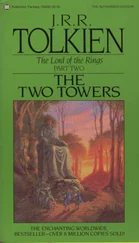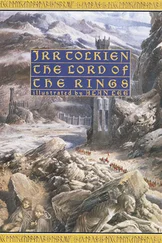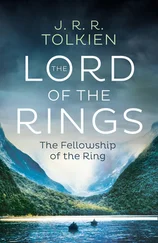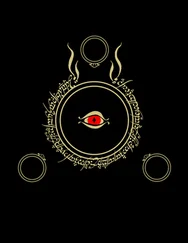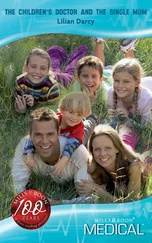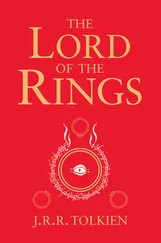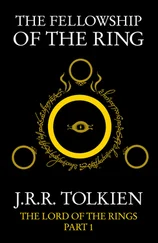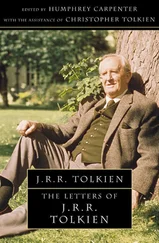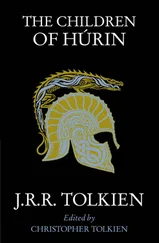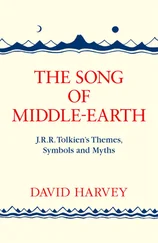This prophecy was fulfilled when Tuor, first cousin to Túrin, came to Gondolin and wedded Idril, daughter of Turgon; for their son was Eärendil: the ‘new star’, ‘hope of Elves and Men’, who escaped from Gondolin. In the prose saga of The Fall of Gondolin that was to be, begun probably in 1951, my father recounted the journey of Tuor and his Elvish companion, Voronwë, who guided him; and on the way, alone in the wilderness, they heard a cry in the woods:
And as they waited one came through the trees, and theysaw that he was a tall Man, armed, clad in black, with a longsword drawn; and they wondered, for the blade of thesword also was black, but the edges shone bright and cold.
That was Túrin, hastening from the sack of Nargothrond ( †); but Tuor and Voronwë did not speak to him as he passed, and ‘they knew not that Nargothrond had fallen, and this was Túrin son of Húrin, the Blacksword. Thus only for a moment, and never again, did the paths of those kinsmen, Túrin and Tuor, draw together.’
In the new tale of Gondolin my father brought Tuor to the high place in the Encircling Mountains from where the eye could travel across the plain to the Hidden City; and there, grievously, he stopped, and never went further. And so in The Fall of Gondolin likewise he failed of his purpose; and we see neither Nargothrond nor Gondolin with his later vision.
I have said elsewhere that ‘with the completion of the great “intrusion” and departure of The Lord of the Rings , it seems that he returned to the Elder Days with a desire to take up again the far more ample scale with which he had begun long before, in The Book of Lost Tales. The completion of the Quenta Silmarillion remained an aim; but the “great tales”, vastly developed from their original forms, from which its later chapters should be derived , were never achieved.’ These remarks are true of the ‘great tale’ of The Children of Húrin as well; but in this case my father achieved much more, even though he was never able to bring a substantial part of the later and hugely extended version to final and finished form.
At the same time as he turned again to the Lay of Leithian and The Fall of Gondolin he began his new work on The Children of Húrin , not with Túrin’s childhood, but with the latter part of the story, the culmination of his disastrous history after the destruction of Nargothrond. This is the text in this book from The Return of Túrin to Dor-lómin ( †) to his death. Why my father should have proceeded in this way, so unlike his usual practice of starting again at the beginning, I cannot explain. But in this case he left also among his papers a mass of later but undated writing concerned with the story from Túrin’s birth to the sack of Nargothrond, with great elaboration of the old versions and expansion into narrative previously unknown.
By far the greater part of this work, if not all of it, belongs to the time following the actual publication of The Lord of the Rings. In those years The Children of Húrin became for him the dominant story of the end of the Elder Days, and for a long time he devoted all his thought to it. But he found it hard now to impose a firm narrative structure as the tale grew in complexity of character and event; and indeed in one long passage the story is contained in a patchwork of disconnected drafts and plot-outlines.
Yet The Children of Húrin in its latest form is the chief narrative fiction of Middle-earth after the conclusion of The Lord of the Rings ; and the life and death of Túrin is portrayed with a convincing power and an immediacy scarcely to be found elsewhere among the peoples of Middle-earth. For this reason I have attempted in this book, after long study of the manuscripts, to form a text that provides a continuous narrative from start to finish, without the introduction of any elements that are not authentic in conception.
(2) THE COMPOSITION OF THE TEXT
In Unfinished Tales , published more than a quarter of a century ago, I presented a partial text of the long version of this tale, known as the Narn , from the Elvish title Narn i Chîn Húrin , the Tale of the Children of Húrin. But that was one element in a large book of various content, and the text was very incomplete, in keeping with the general purpose and nature of the book: for I omitted a number of substantial passages (and one of them very long) where the Narn text and that in the much briefer version in The Silmarillion are very similar, or where I decided that no distinctive ‘long’ text could be provided.
The form of the Narn in this book therefore differs in a number of ways from that in Unfinished Tales , some of them deriving from the far more thorough study of the formidable complex of manuscripts that I made after that book was published. This led me to different conclusions about the relations and sequence of some of the texts, chiefly in the extremely confusing evolution of the legend in the period of ‘Túrin among the Outlaws’. A description and explanation of the composition of this new text of The Children of Húrin follows here.
An important element in all this is the peculiar status of the published Silmarillion ; for as I have mentioned in the first part of this Appendix my father abandoned the Quenta Silmarillion at the point that he had reached (Túrin’s becoming an outlaw after his flight from Doriath) when he began The Lord of the Rings in 1937. In the formation of a narrative for the published work I made much use of The Annals of Beleriand , originally a ‘Tale of Years’, but which in successive versions grew and expanded into annalistic narrative in parallel with the successive ‘Silmarillion’ manuscripts, and which extended to the freeing of Húrin by Morgoth after the deaths of Túrin and Niënor.
Thus the first passage that I omitted from the version of the Narn i Chîn Húrin in Unfinished Tales (p. 58 and note 1) is the account of the sojourn of Húrin and Huor in Gondolin in their youth; and I did so simply because the tale is told in The Silmarillion (pp. 158–9). But my father did in fact write two versions: one of them was expressly intended for the opening of the Narn , but was very closely based on a passage in The Annals of Beleriand , and indeed for most of its length differs little. In The Silmarillion I used both texts, but here I have followed the Narn version.
The second passage that I omitted from the Narn in Unfinished Tales (pp. 65–6 and note 2) is the account of the Battle of Unnumbered Tears, an omission made for the same reason; and here again my father wrote two versions, one in the Annals , and a second, much later but with the Annals text in front of him, and for the most part closely followed. This second narrative of the great battle was, again, expressly intended as a constituent element in the Narn (the text is headed Narn II, i.e. the second section of the Narn ), and states at the outset ( †in the text in this book): ‘Here there shall be recounted only those deeds which bear upon the fate of the House of Hador and the children of Húrin the Steadfast.’ In pursuit of this my father retained from the Annals account only the description of the ‘westward battle’ and the destruction of the host of Fingon; and by this simplification and reduction of the narrative he altered the course of the battle as told in the Annals . In The Silmarillion I of course followed the Annals , though with some features taken from the Narn version; but in this book I have kept to the text that my father thought appropriate to the Narn as a whole.
Читать дальше
Конец ознакомительного отрывка
Купить книгу

